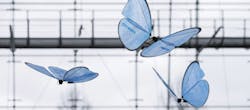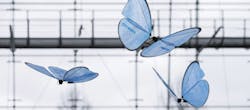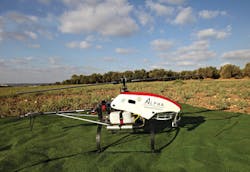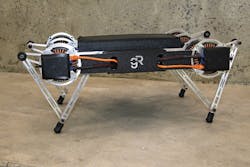November 2016 snapshots: UAVs and robotics, multispectral surveillance
Vision system helps bionic butterflies coordinate flying
Festo (Esslingen am Neckar, Germany;www.festo.com), a global company in automation, technical training, and development, recently demonstrated its eMotionButterflies project, which shows how several autonomous flying objects can move independently in an enclosed space without colliding.
eMotionButterflies was developed as part of a research program to develop technologies, applications, and solutions for potential future industrial production processes. Festo notes that the integrated technologies and the overall networked sensor system are, in principle, possible solutions for future industrial logistics applications. In order to coordinate flying for the butterflies and make it so that they don't crash into each other, Festo utilized indoor GPS and an infrared camera-based vision system.
Ten near infrared cameras were installed in the room to record the butterflies, which were equipped with infrared markers. The cameras used were GS3-U3-41C6NIR-C cameras from Point Grey (Richmond, BC, Canada;www.ptgrey.com). These cameras feature a 4.1 MPixel near-infrared CMOSIS (Antwerp, Belgium; www.cmosis.com) CMV4000-3E12 CMOS image sensor, which features a 5.5 μm pixel size and can reach a frame rate of 90 fps in full resolution. Used with these cameras were BN850 near-infrared bandpass filters from Midwest Optical Systems (Palatine, IL, USA; www.midopt.com). These filters block unwanted ambient light while only passing the signal from 850 nm IR LEDs to the cameras.
The cameras transmitted position data to a central master computer, which coordinates the butterflies from the outside, acting like an "air traffic controller." The intelligent networking system creates a guidance and monitoring system, which Festo suggested could be used in the networking factory of the future.
Infrared-camera equipped UAV assists in agricultural research
In order to perform various agricultural research tasks, researchers in Israel have deployed two unmanned aerial vehicles (UAV) equipped with infrared cameras.
Based in Bet-Dagan, Israel, the Agricultural Research Organization (ARO;www.agri.gov.il/en) comprises six institutes responsible for plant sciences; animal science; plant protection, soil, water, and environmental engineering; agricultural engineering; and postharvest and food sciences. ARO also operates four research stations around the country, and serves as a testing center for agricultural produce and equipment.
To perform agricultural research tasks including hydric stress, disease detection, and soil nutrients optimization, ARO purchased two SNIPER UAVs from Alpha Unmanned Systems (Madrid, Spain;www.alphaunmannedsystems.com). SNIPER is a 5.5 x 1.9 ft. helicopter two-stroke gasoline piston engine helicopter UAV that reaches speeds of nearly 35 mph for up to 2 hours at a time. To accomplish the task of monitoring the crops, a FLIR (Wilsonville, OR, USA; www.flir.com) SC-655 infrared camera was installed on each of the UAVs.
The FLIR SC-655 features a 640 x 480 uncooled microbolometer LWIR focal plane array with a 17 μm pixel size that acquires full frame 16-bit data at speeds of up to 50 fps. The camera, which is GigE Vision and GenICam compliant, also features focal plane array windowing for high-speed 200 Hz imaging. With this infrared camera, each drone can capture images in the 7.5 - 14 μm spectral range. Also on the SNIPER UAV is an on-board processing computer.
Once the UAVs were delivered and accepted by the Israeli authority, Alpha Unmanned Systems provided a training program in Madrid, Spain for two ARO pilots and two pilots recognized by the Israel Civil Aviation Authority (ICAA). Following the training, Alpha traveled to Tel-Aviv, Israel to complete the acceptance test procedure (ATP) and to perform the first flight tests required to achieve certification with the ICAA. Both flights and tests were successful and met ATP and ICAA requirements.
Each SNIPER unit can carry up more than 5.5 lbs in payload, and will support ARO in their precision agriculture research.
Multispectral camera for surveillance being developed by European Commission
As part of the European Commission (https://ec.europa.eu), the Community Research and Development Information Service (CORDIS; cordis.europa.eu/) is funding a project to develop a snapshot multispectral camera featuring the latest photonics technologies that will be used for surveillance applications.
Designed for applications such as coastal surveillance, the multispectral camera will measure the size of a shoebox and weigh less than 2 kg. It will feature a multi-aperture, multi-sensor design and will be able to capture several wavelengths simultaneously in one place. In addition to surveillance, the camera will play a role in the monitoring of greenhouse gases as well.
The World Health Organization (Geneva, Switzerland;www.who.int), according to a press release, estimates that in 2014, nearly 600,000 deaths came as a result of air pollution in Europe. This new multispectral camera, which is dubbed SEERS (Snapshot spectral imager for IR surveillance; www.seersproject.eu), will help monitor gases and play a key role in safety and security in the areas in which it is deployed. Furthermore, the camera will be used for safety in tunnels and for underground trains.
"Accidents in tunnels, while rare, are extremely serious when they do happen. Responding quickly and in a targeted manner is vital. We expect rescue and response times will be cut significantly with the SEERS camera", Anton Garcia-Diaz, Project Coordinator, said.
SEERS has received a grant of €3,750,535 from Horizon 2020 via the Photonics Public Private Partnership. Garcia-Diaz offered further comments on the camera:
"The SEERS device is equipped with integrated computational imaging. It has no need for cooling and can process the images in real-time, meaning key parts of processing are embedded within the device."
The stated goal of the SEERS project is to first develop the multispectral imager, then adopt an embedded approach for image reconstruction, cognitive image fusion, video pre-processing, and event-driven operation. From there, the team will utilize a novel video analytics solution for smart networked operation. The camera, according to CORDIS, will feature a microbolometer focal plane array adapted to multi-aperture imaging requirements, a spectral optical design that combines beam splitting and multi-aperture imaging, multi-aperture sensor arrays for multispectral and super-resolution imaging, and embedded image processing features. SEERS will "enable robust intelligent surveillance with event-driven and smart performance," suggested the CORDIS project page.
Climbing robot opens doors
Ghost Robotics (Philadelphia, PA, USA;www.ghostrobotics.io) has announced the launch of its first direct-drive legged autonomous robot platform, Ghost Minitaur that is built for instantaneous and precise force feedback applications and movement random terrains.
Ghost Minitaur is a 1.3 ft (hip to hip) x 0.9 ft (toe to toe, standing), fully-assembled quadrupedal robot that weighs just over 11 lbs. and can carry a payload of more than 6.5 lbs. The robot features an Arduino-compatible (https://www.arduino.cc) robot microcontroller based on an STM32F303 from STMicroelectronics (Geneva, Switzerland; www.st.com) running at 72 MHz. It features a Picatinny rail system for payload, senor, and manipulator attachment and features high torque motors and specialized leg design which allows the robot to run and jump over difficult terrain while actively balancing, climbing fences, reorienting from fall, and even opening doors. High-speed and high-resolution encoders enable the robot to "see" and "feel" the ground through the motors and adapt accordingly.
Ghost Robotics was founded in October of 2015 by University of Pennsylvania (Philadelphia, PA, USA;www.upenn.edu) PhD candidates, Avik De and Gavin Kenneally, and is backed by the University of Pennsylvania and PCI Ventures (Philadelphia, PA, USA; www.pci.upenn.edu/pciventures) which incubate Penn's leading research and innovations. The company is researching and building next-generation legged robots and its underlying research and intellectual property have additional applications in surgery, lab operations, healthcare and advanced gait research, according to a press release. "We are extremely excited to be launching our first commercial robot platform, Ghost Minitaur™," said Gavin Kenneally, Co-founder of Ghost Robotics. "This has been a long journey in the conceptualization and development of the robot, and we see many applications for the platform ahead and underlying technology," added Avik De, Co-founder.
A key application of the Ghost Minitaur, according to the company, is a deployment of the robot as an autonomous sensor vehicle for public safety, military, exploration, mining, agricultural and hazardous environment operation, as well as advanced gait research and development.
"The forward thinking vision of both Gavin and Avik is quite impressive," said Jiren Parikh, Ghost Robotics, CEO. "The market opportunity for legged robots in operating environments where wheeled or tracked robots have limitations is substantial."




